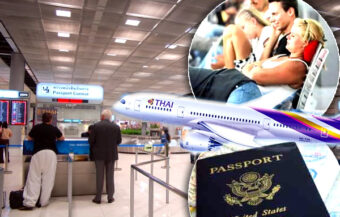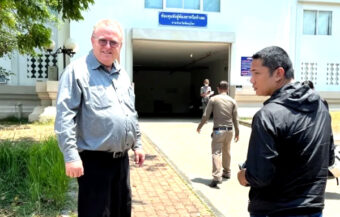It appears that the airline, kept alive by cargo freight income and the protection of the court through the pandemic emergency, has made substantial progress in trimming its previously huge cost base while capturing market share as the country reopened with other international airlines, for now, scrambling after richer pickings while others are not able to compete on routes to Bangkok as before. However, Bangkok Bank, a key dissenting creditor in a submission to the Central Bankruptcy Court has expressed its doubts about the firm’s high-flying plans to find further credit which includes an expressed intention to relaunch itself on the stock market by 2025.
As part of its revised business plan approved by the Central Bankruptcy Court in Bangkok on Thursday, Thai Airways will finally begin refunding ticket purchases made by customers before it filed for bankruptcy in May 2022. Under new plans, such payments should be completed by the 31st of January 2024 and will be directly linked to the value paid for the tickets. The airline which has had its operating performance boosted since the reopening of Thailand earlier this year is projected to fly 4.4 million passengers in 2022 with an average flight load of about 80%. However, there are still challenges with the airline still restricted from flying to certain countries or territories fearing action by key dissenting creditors and comments from Bangkok Bank, which opposes the plan, to the court since September questioning the airline’s ability to access further credit to implement its business plan by the end of 2024, the cornerstone of which is a ฿25 billion rights issue with debts owed to creditor converted into capital before the airline is again refloated on the stock exchange.

The Central Bankruptcy Court in Bangkok, on Thursday, approved key elements of a revised business reorganisation plan as part of efforts to restructure the debts of the country’s flag carrier Thai Airways.
A key part of the plan given the green light by the Central Bankruptcy Court which communicated its decision by digital means, was a plan to refund passenger prepayments made before the airline filed for bankruptcy in May 2020.
Refund payments paid through credit cards and other means, to be complete by the 31st of January 2024
Under revised provisions, agreed by the court on Thursday, these payments are expected to be paid, in many cases through the refund of credit card payments, to passengers by the end of January 2024.
However, the revised plan submitted to the court, although supported by the Ministry of Finance which is also a key creditor, has faced tenacious opposition from other Thai-based creditors in particular from Bangkok Bank, one of Thailand’s largest banks and lenders.
Thai Airways flies high as numbers skyrocket as it flies tourists into the kingdom from Europe
In its judgement, on Thursday, the court reviewed proposals to amend the plans in respect of creditors abroad who are threatening to seize Thai Airways aircraft because of outstanding debt despite the bankruptcy process.
Management wanted to deal with creditors threatening to seize Thai Airways aircraft in key territories as a priority, it is a key problem
This, according to management, is proscribing the ability of those working to rehabilitate the airline’s business to operate a fuller flight schedule in response to market conditions.
The amended plan was supported by a majority of the airline’s creditors this September but still required approval of the court on Thursday after it vetted the proposal in considerable detail and listened to opposition from dissenting creditors.
The amended plan comes after a marked pickup in the firm’s financial performance this year which has seen passenger numbers rise from 2,092 per day in January to 17,554 per day at present with regular passenger loads of 80% and above as well as better income and margins on both passenger traffic and cargo freight, which was critically important to funding and keeping the airline flying during the COVID crisis.
Leaner Thai Airways with lower operating costs is filling seats on flights again this year from Europe
The airline, in the course of its rehabilitation, has seen a halving of its workforce from twenty-nine thousand personnel to fourteen thousand four hundred with a resultant monthly wage bill of ฿700 million, reduced from ฿3 billion per month previously.
The airline has reduced its aircraft fleet to 58 planes, in the process, selling off 45 aircraft while it is expected to have taken delivery of three new Boeing 777-330 ER aircraft in October with two of these planes already delivered on October 18th and 19th while the third is due on October 26th.
These aircraft are suitable for lucrative long-haul flights and come with room for 8 first-class passengers, 40 business-class passengers and 255 seats for those flying economy.
Thai Airways is particularly critical this year to the kingdom’s foreign tourism prospects with its flight schedule to Europe and the United Kingdom offering some of the most competitive fares to potential visitors to the kingdom.
Even March 2023 in doubt for resumption of British Airways direct flight from London to Bangkok
The airline expects to have a busy and successful high season in the runup to Christmas 2022 and the 2023 New Year season with other international airlines busy pursuing more lucrative destinations than Bangkok.
Drawn out process where the Bankruptcy Court keeps oversight over all key decisions regarding creditors
The revised business plan, approved on Thursday, was submitted on July 1st last and came after a creditors meeting was held electronically on September 1st 2022.
Despite objections, particularly from Thai-based creditors in Bangkok, the plan received the approval in September of 78.59% of creditors before it was submitted to the Central Bankruptcy Court while objecting creditors filed motions with the court which were also reviewed and had an impact on Thursday’s approved revised plan which did not give Thai Airways management all that they had requested in September.
The plan being pursued was put forward by top executives at the airline including Chief Financial Officer Chai Eamsiri who made a submission to the court in September.
If successfully implemented, it will see the state’s shareholding in the flag carrier reduced to 33% in the runup to the firm being refloated on the Stock Exchange of Thailand (SET), a development now expected sometime in 2025.
Cornerstone of rehabilitation plan is the conversion of debt to equity in a slimmed-down ฿25 billion rights issue before a new stock exchange return
Thai Airways is forecast to fly 4.4 million passengers in 2022 giving it an average cabin load of 80% to 82%.
The amended business plan still anticipates the capitalisation of ฿25 billion within the company between now and the end of 2024 through the sale of new shares and the conversion of existing debt-equity.
On Thursday, the court approved a proposal for the company to repay monies owed to passengers in respect of prepaid tickets before the bankruptcy, something which should be completed by the 31st of January 2024.
The amount to be refunded, under the revised plans approved by the court, will be linked to the value of the tickets paid for by the customer.
Risk of aircraft being seized still exists in some countries and territories, executives sought approval to deal with the problem but the court demurred
The court’s pronouncement on Thursday on the revised plan was detailed and dealt with a proposal from Thai Airways to prioritise payments to key creditors such as ground service providers deemed as essential to the ongoing continuance of the business and the furtherance of its business plans.
The court noted that such a course of action did not disadvantage other creditors
However, it did not immediately approve proposals in the revised plan to deal expeditiously with creditors in countries or territories where there is a risk, according to the airline, of its aircraft being seized.
Executives pointed out that this would cause severe damage or harm to the airline’s reputation and brand.
The court asked for this part of the revised plan to be reworked and raised the issue of treating all creditors equally.
Bangkok Bank has emerged as a key dissenting creditor against the plan and has expressed scepticism about the airline’s ability to find further credit
Bangkok Bank has emerged as a key objector to the firm’s revised business plan and on Thursday, the court noted its contention that the airline will have to generate large amounts of credit to make the plan, as currently finalised, a success before the cornerstone of the rehabilitation process being the conversion of debt to equity, can proceed.
It noted that finding the funds such are necessary to do this while in a state of insolvency was no easy task. It also expressed concern about the airline incurring further debt.
However, the airline’s management pointed to its surging prospects this year with a cash flow of around ฿20 billion and argued before the court that it needed to make changes to continue to push the plan towards its fruition.
Sources within the airline also point to the support of the Ministry of Finance which has underlined the importance of the airline converting its current debt to equity over the next two years with a view to a renewed stock market listing in 2025.
A new financial advisor will now be employed by the airline to put together the ฿25 billion package which has been halved this year due to a better-than-expected operating performance.
Join the Thai News forum, follow Thai Examiner on Facebook here
Receive all our stories as they come out on Telegram here
Follow Thai Examiner here
Further reading:
Thai Airways flies high as numbers skyrocket as it flies tourists into the kingdom from Europe
Thai Airways seeking business rehabilitation plan that has the unanimous support of it’s creditors
Deputy Transport Minister calls talks with Thai Airways, seeks new business plan in 3 months


















